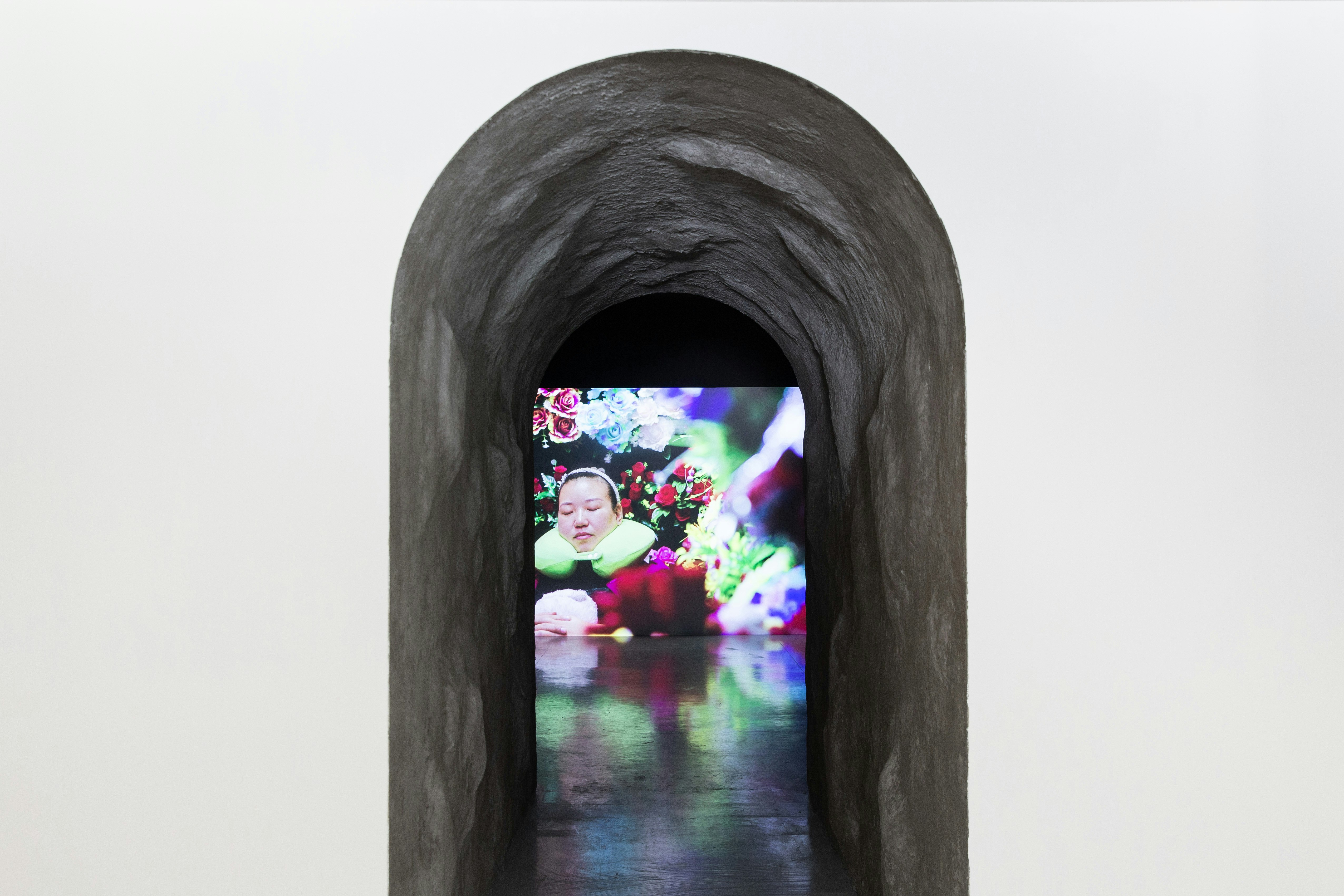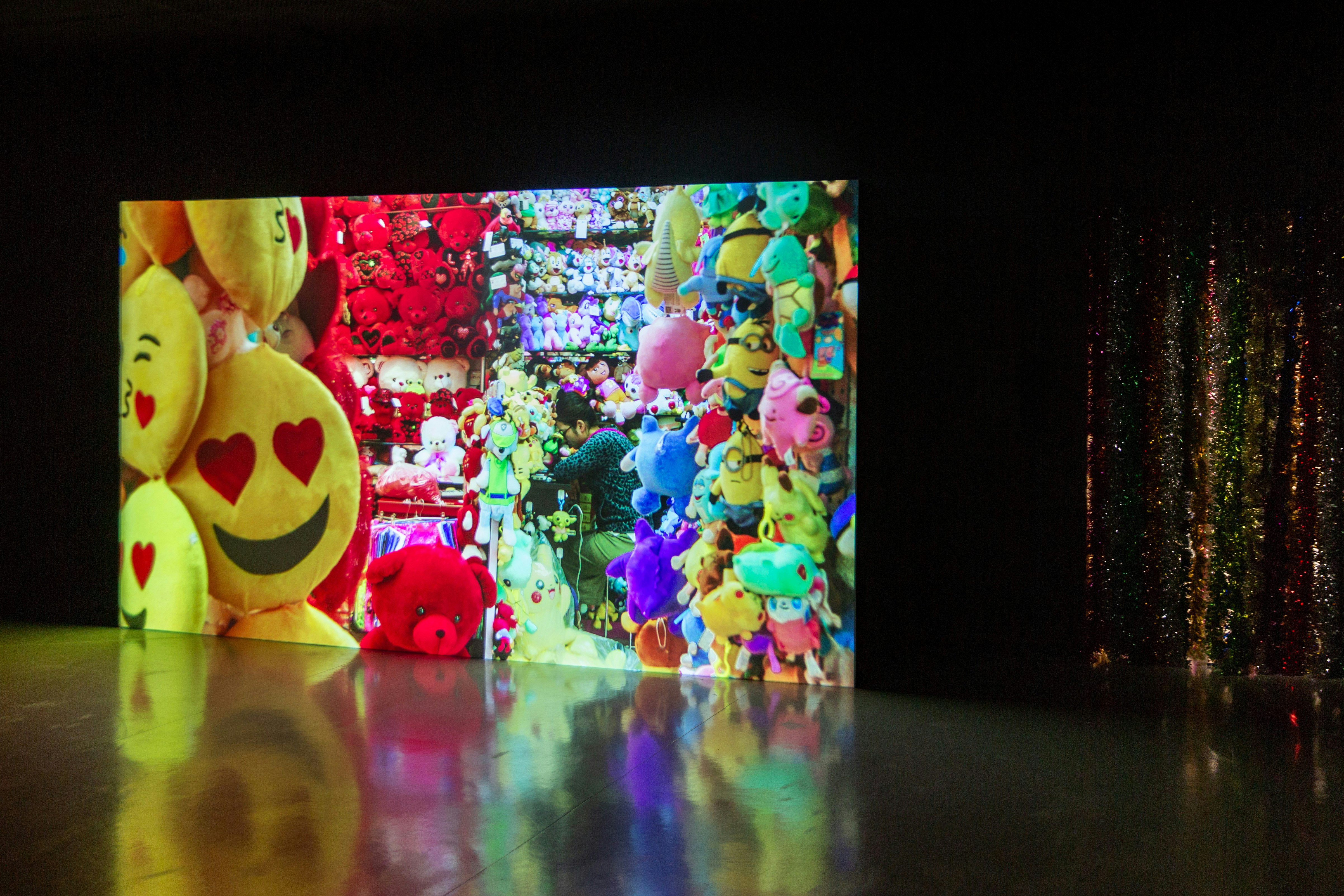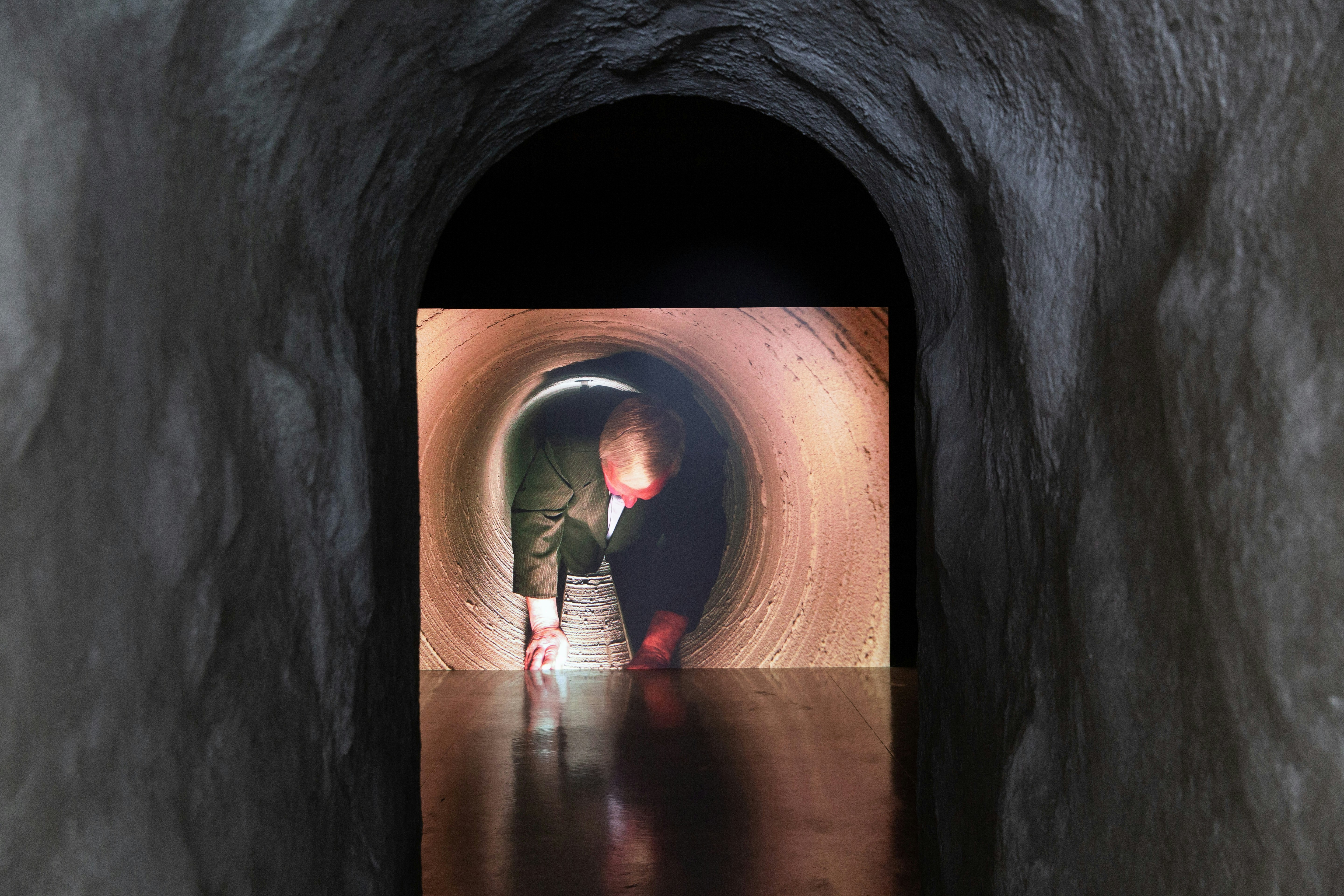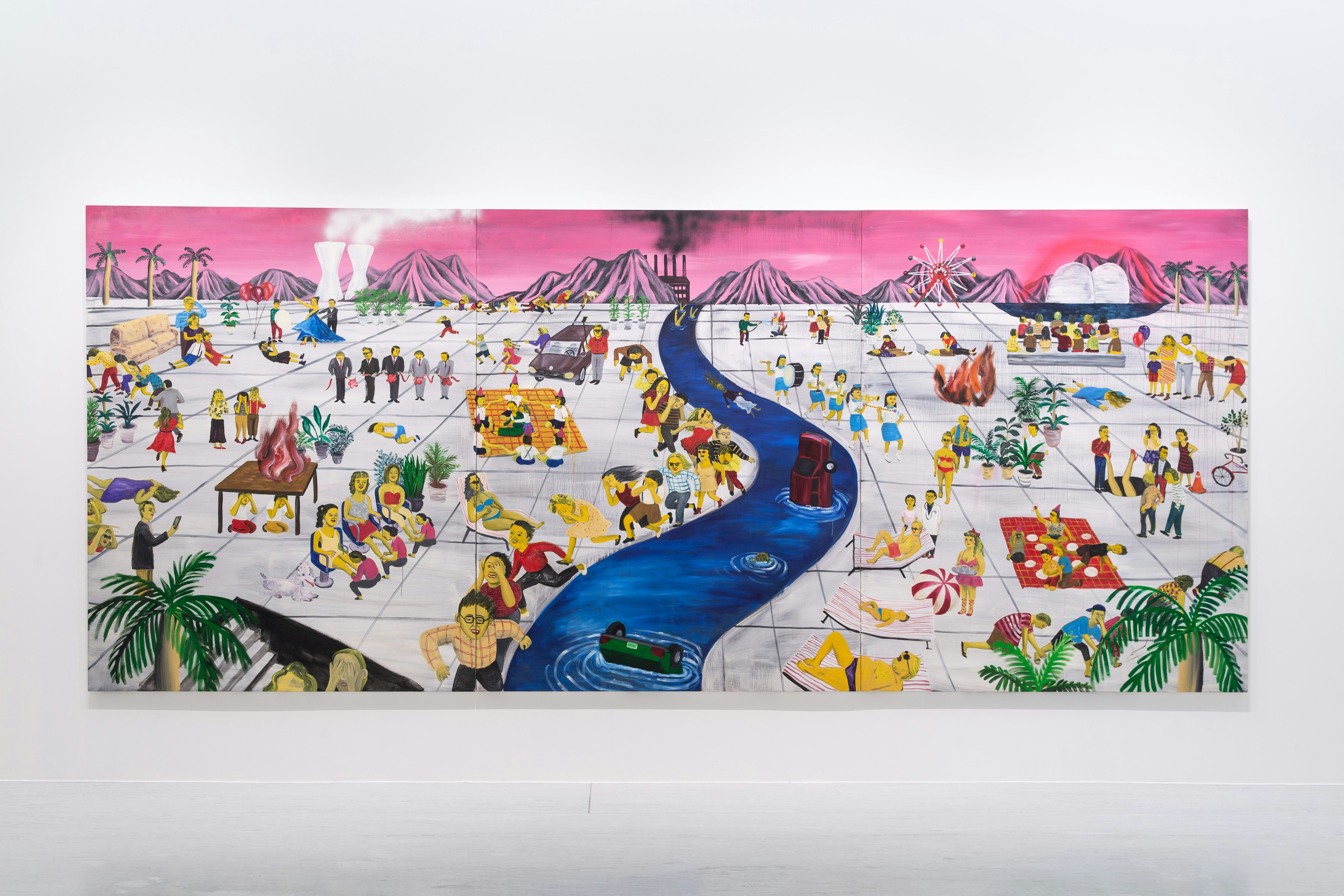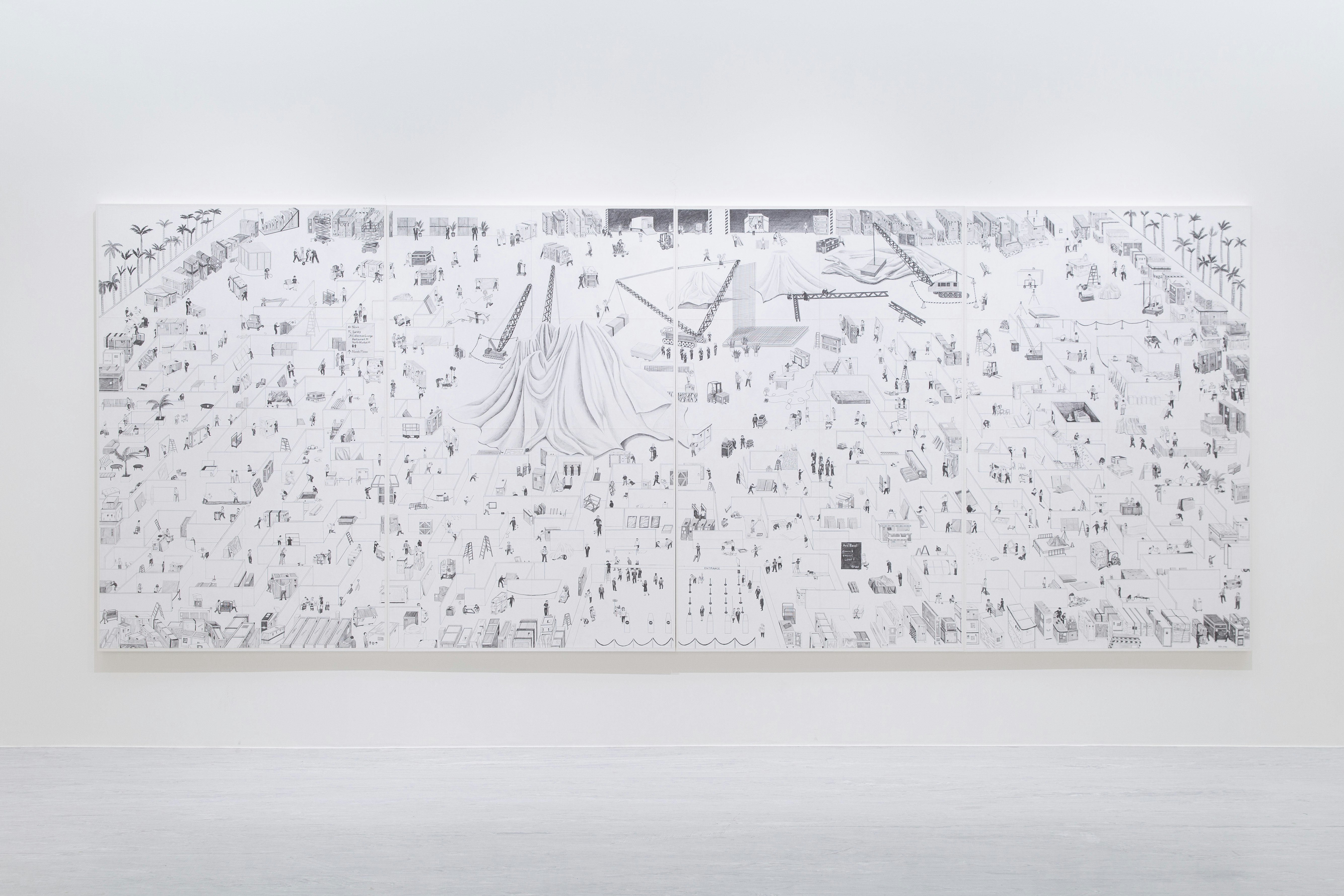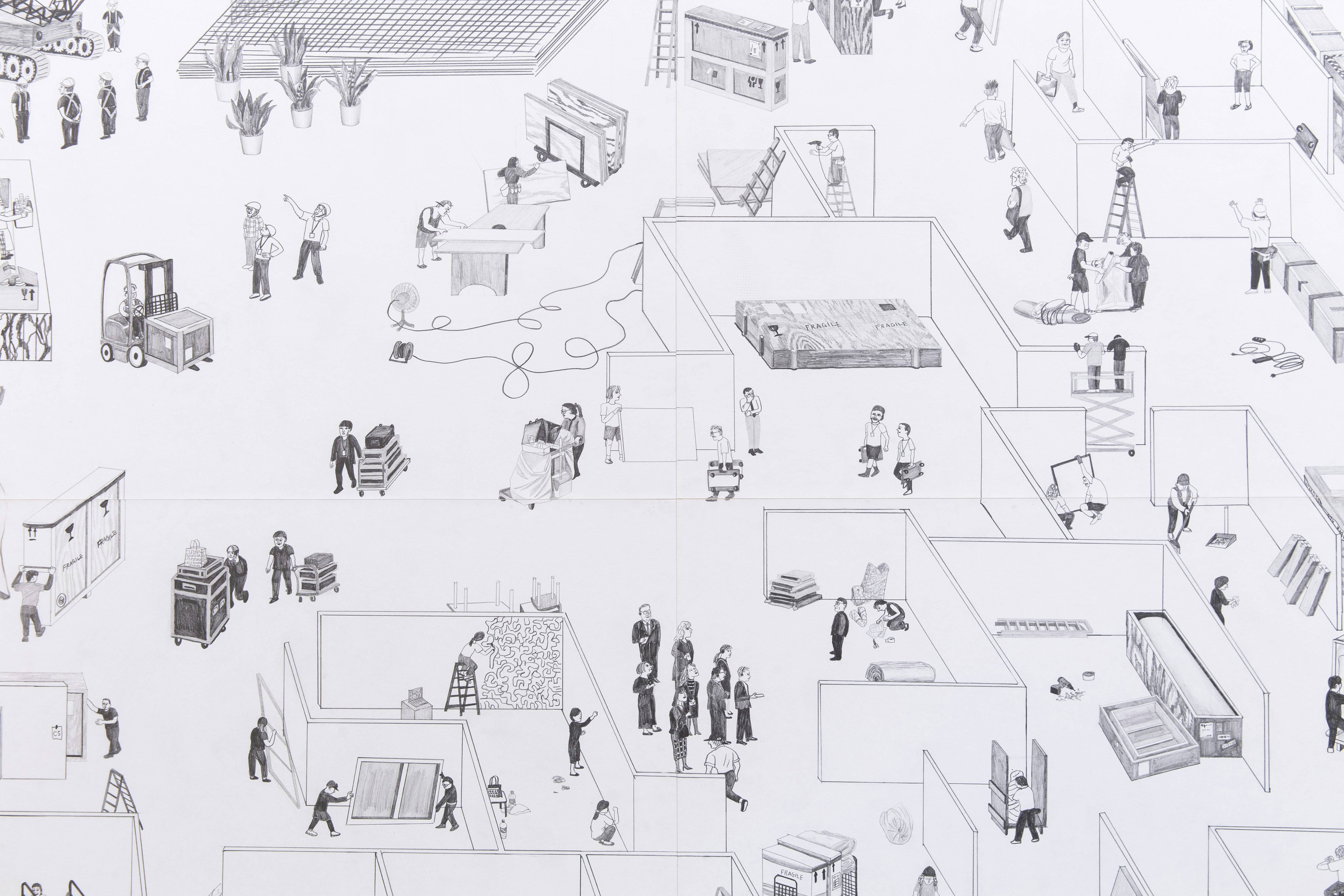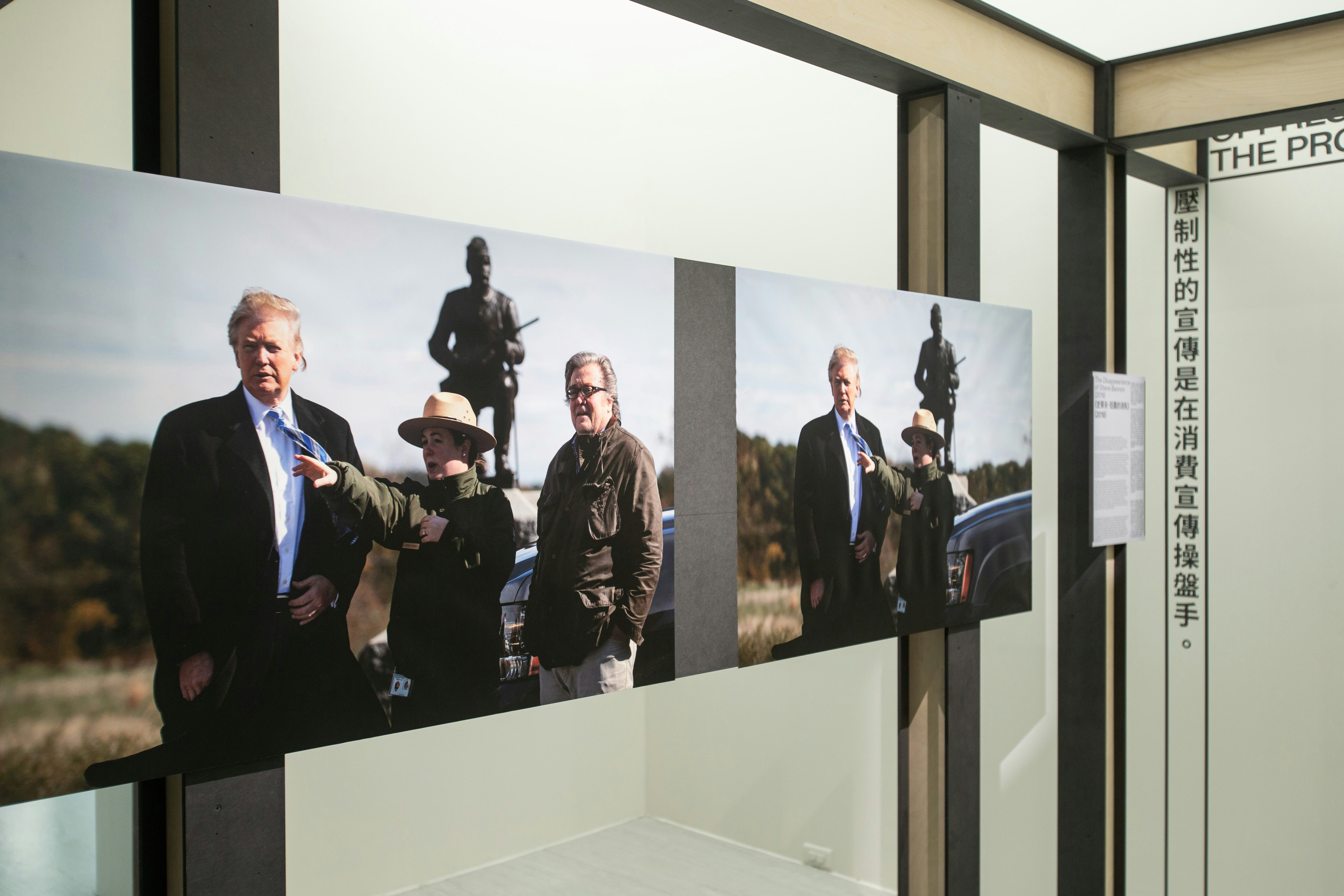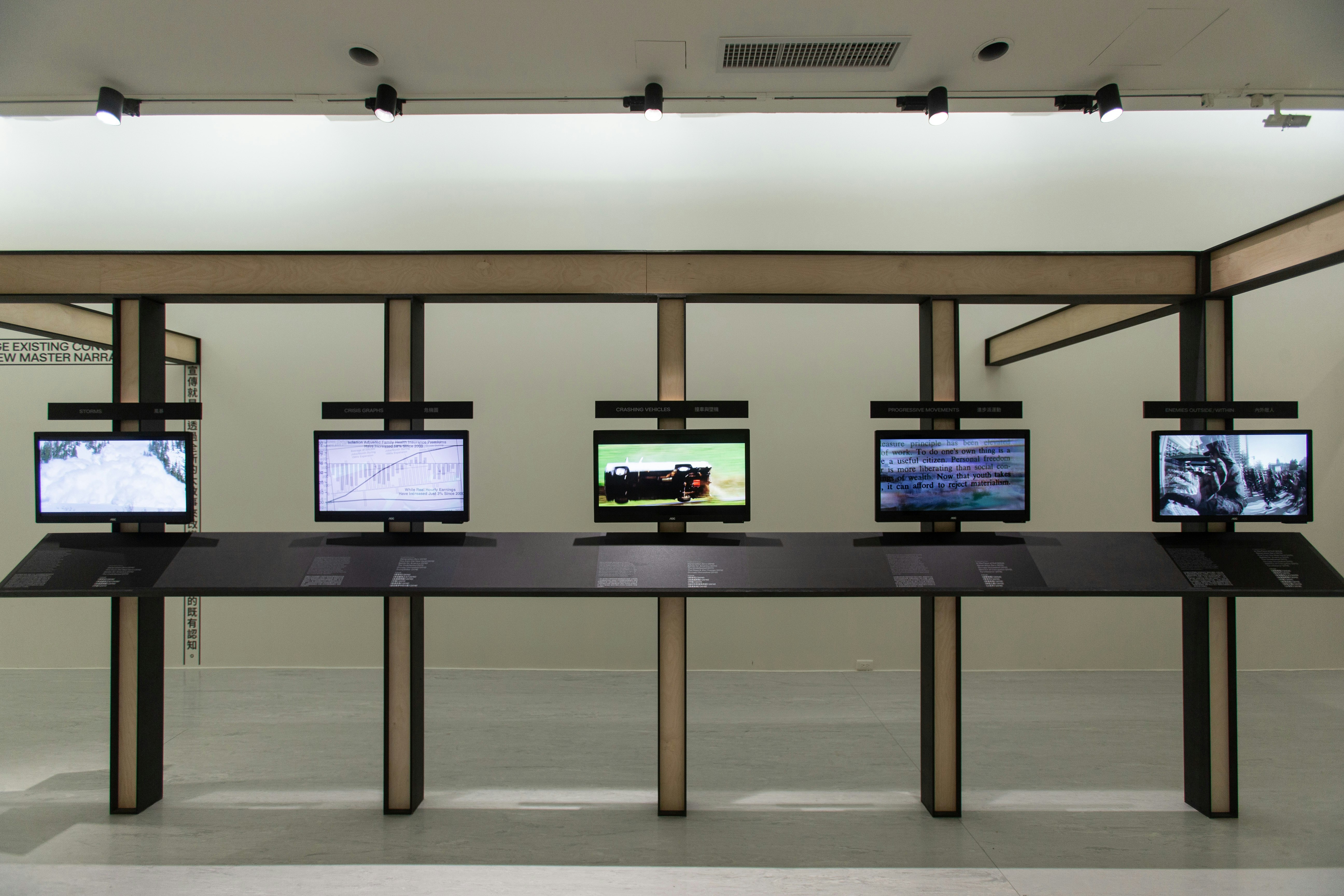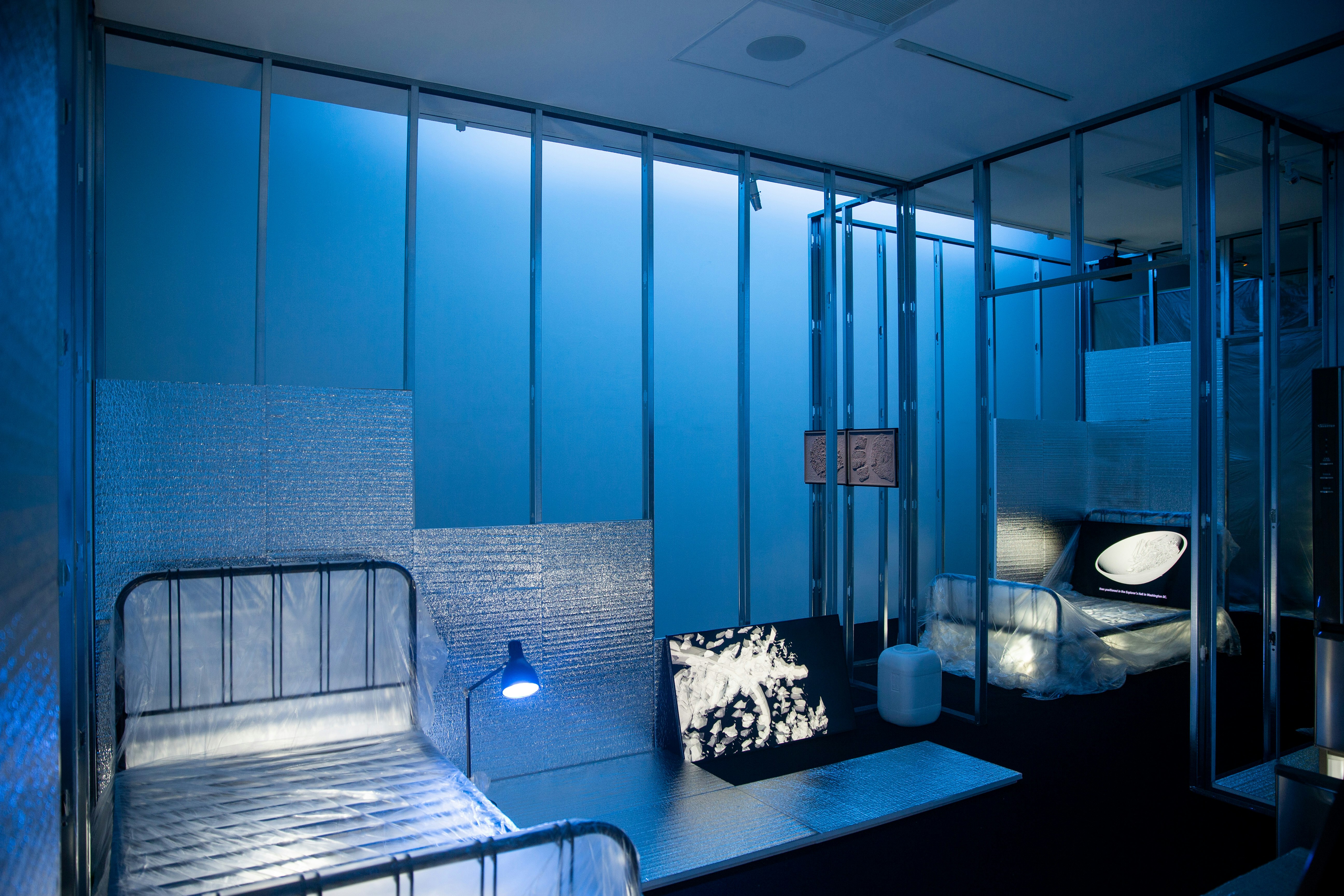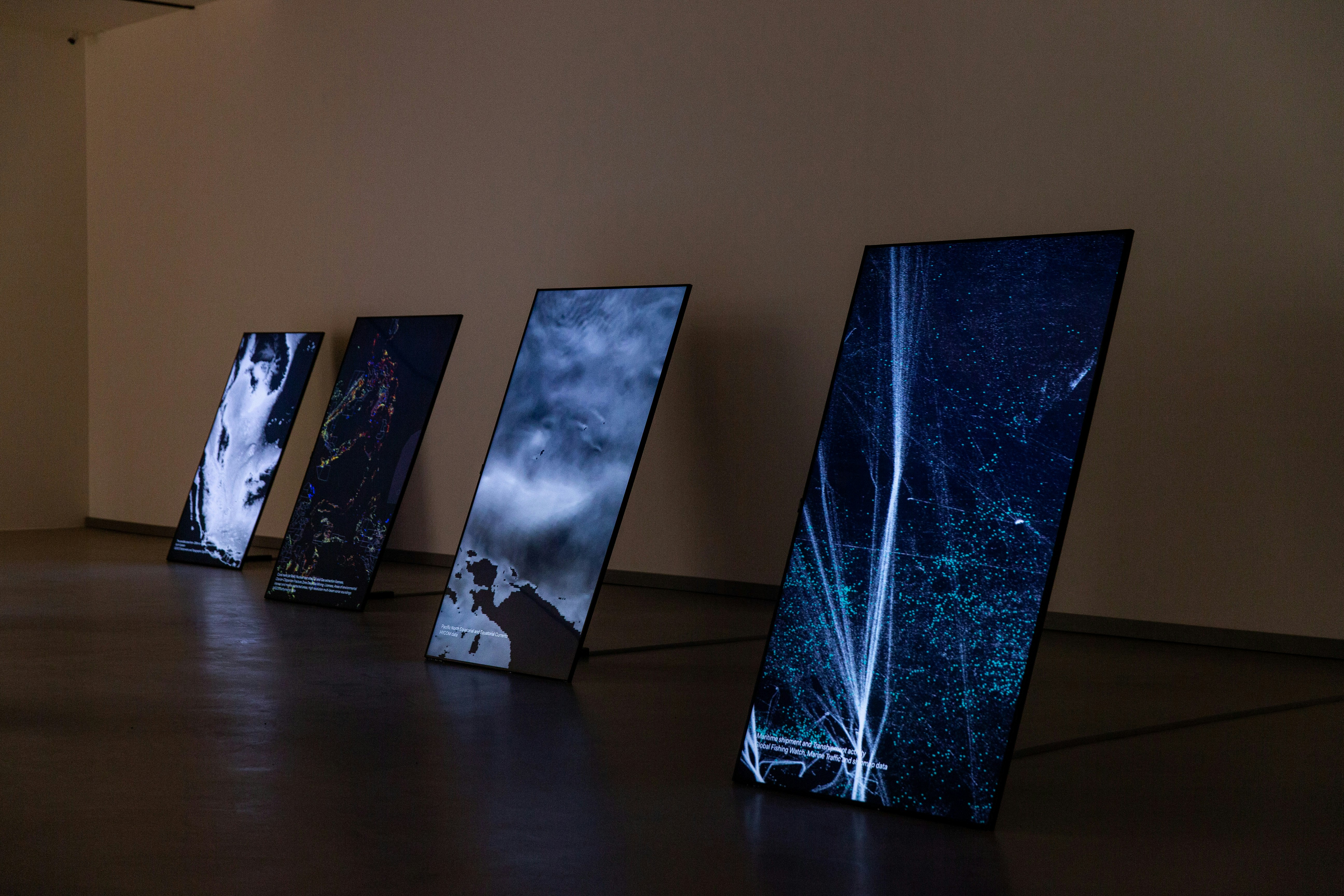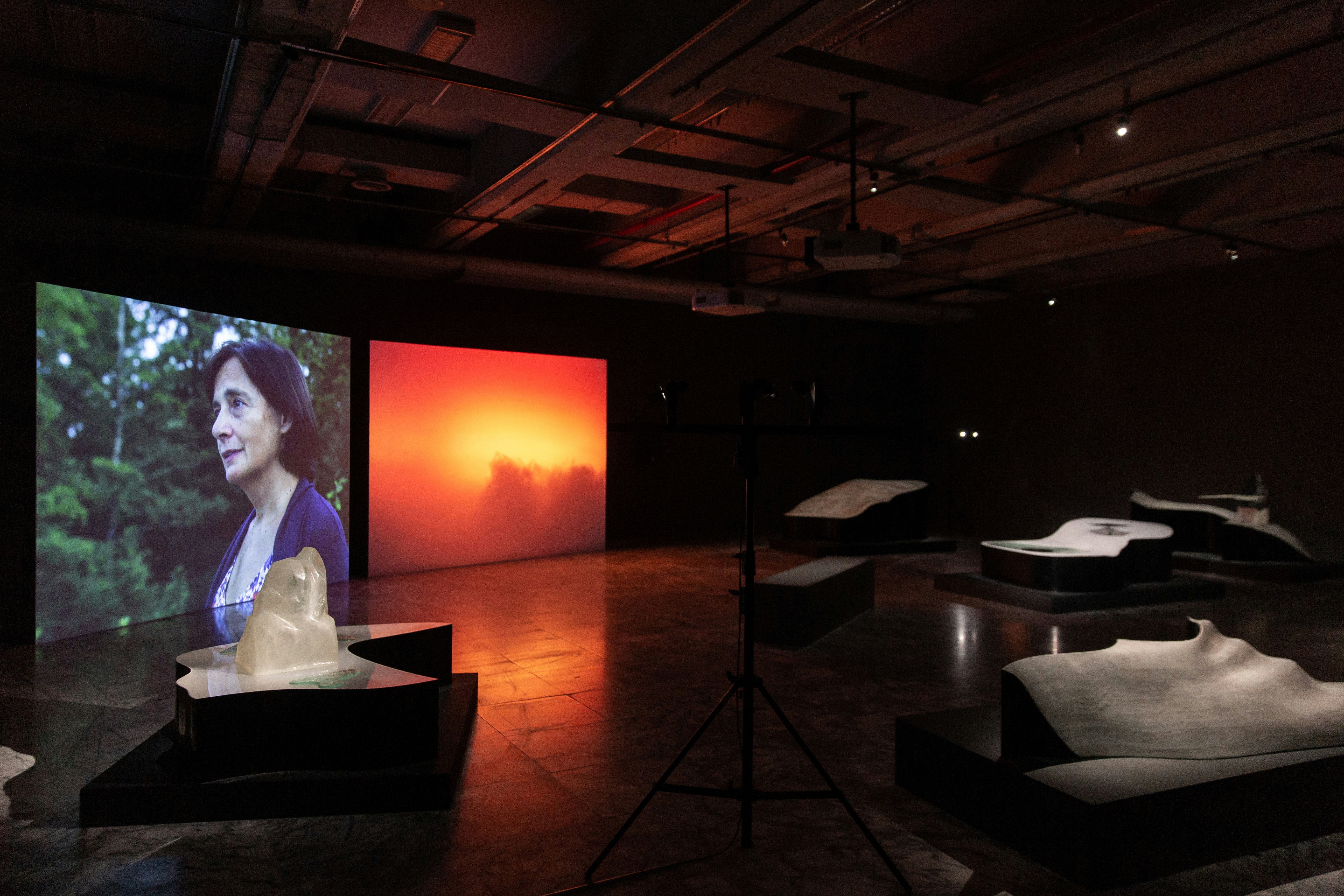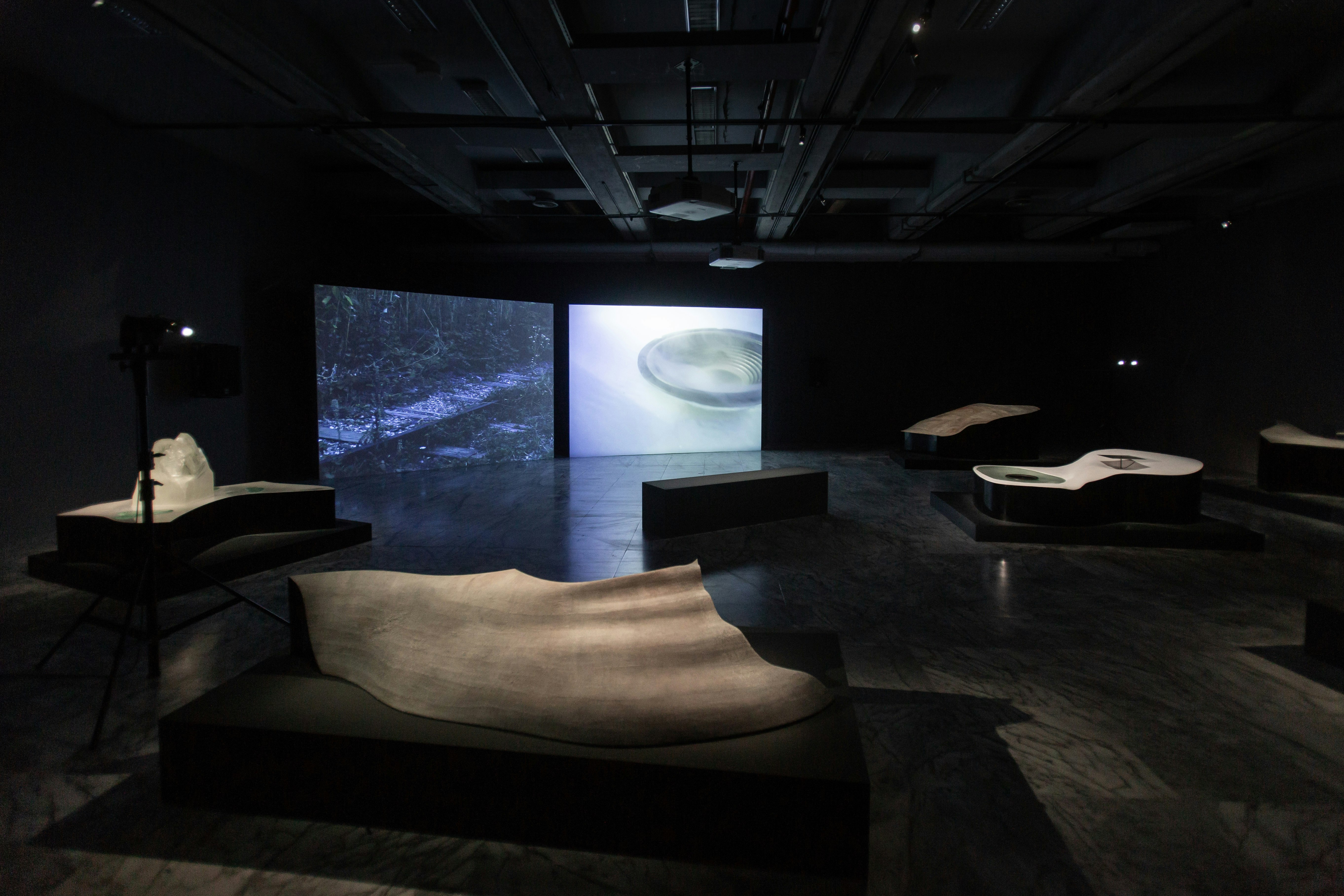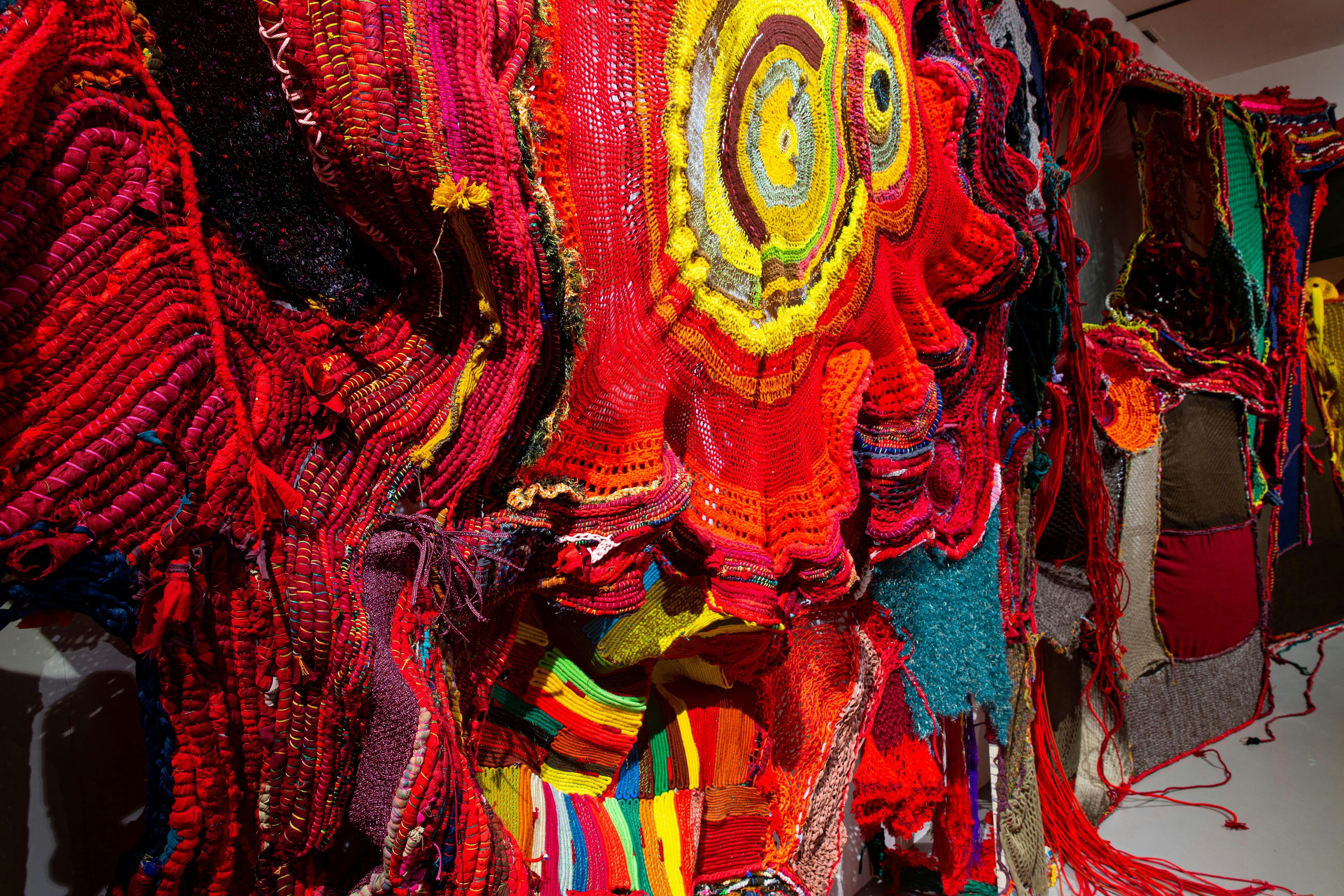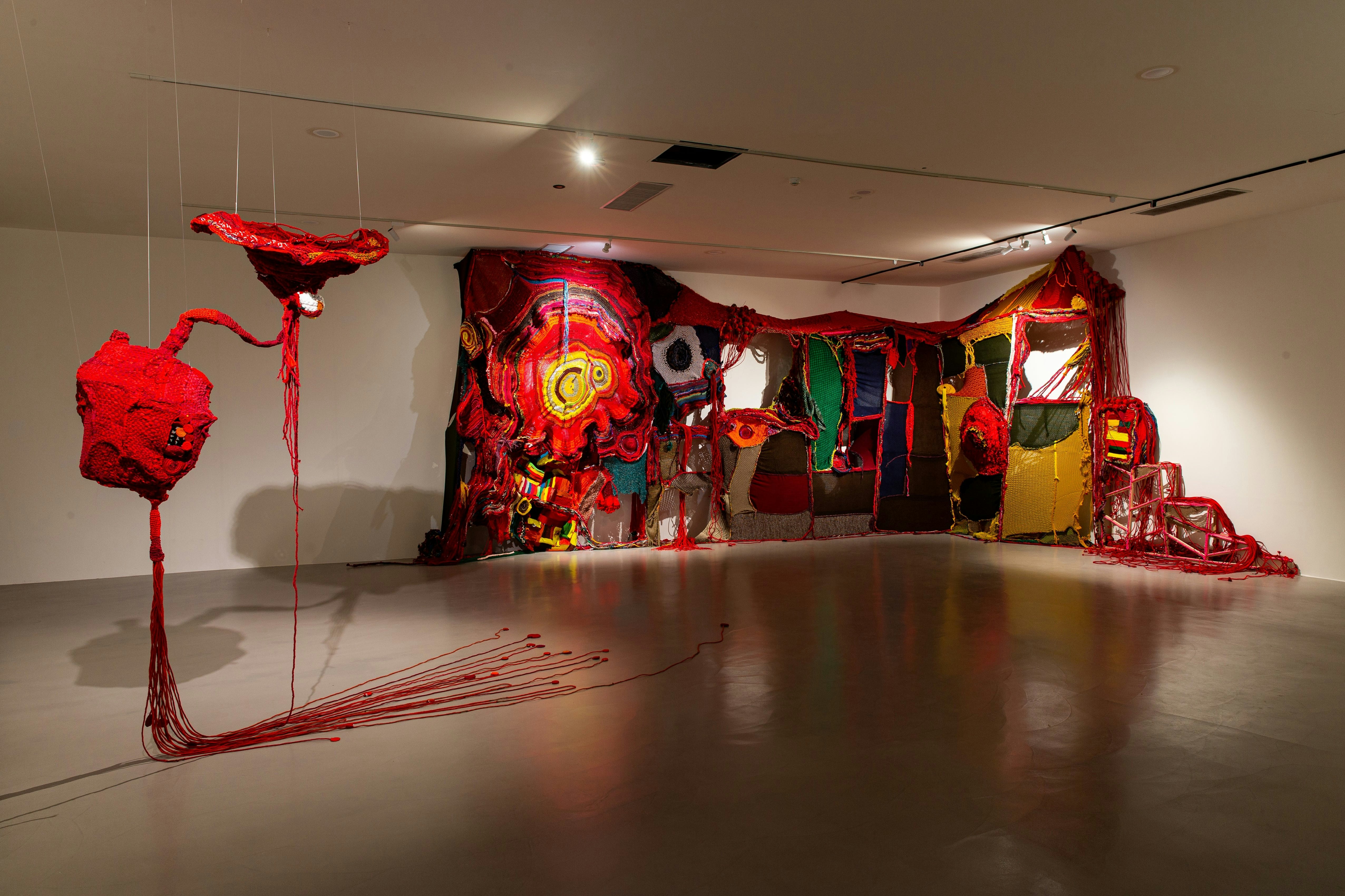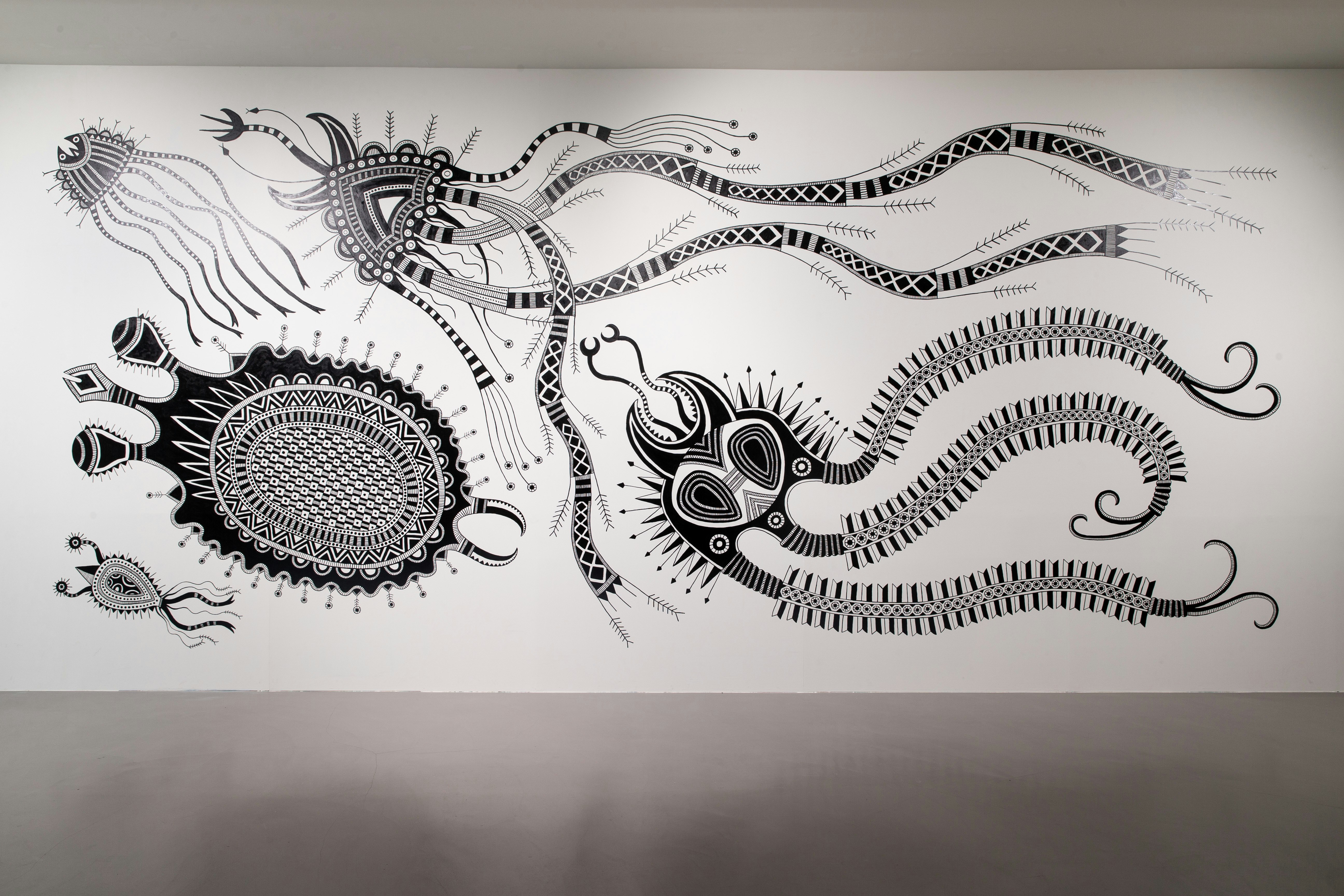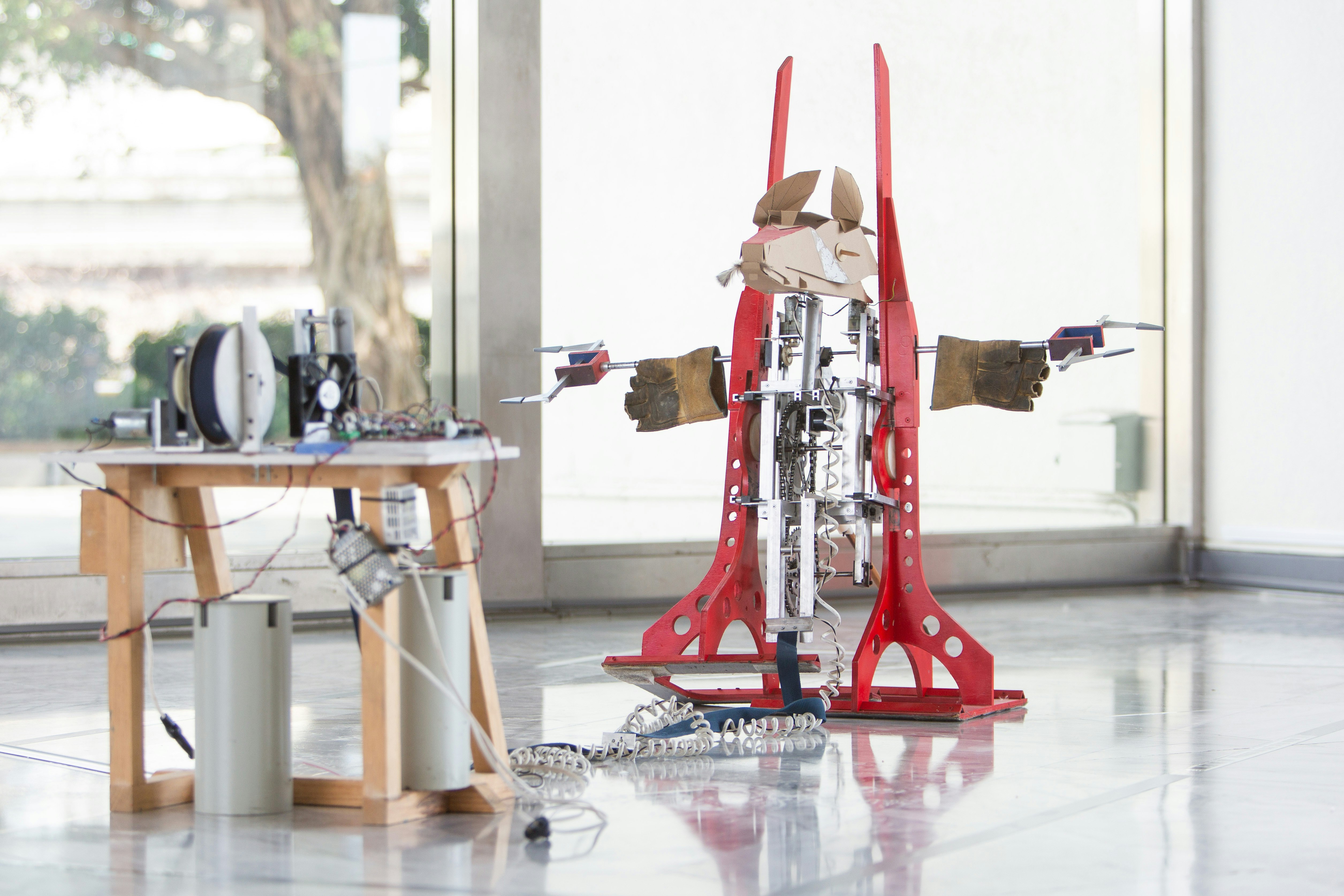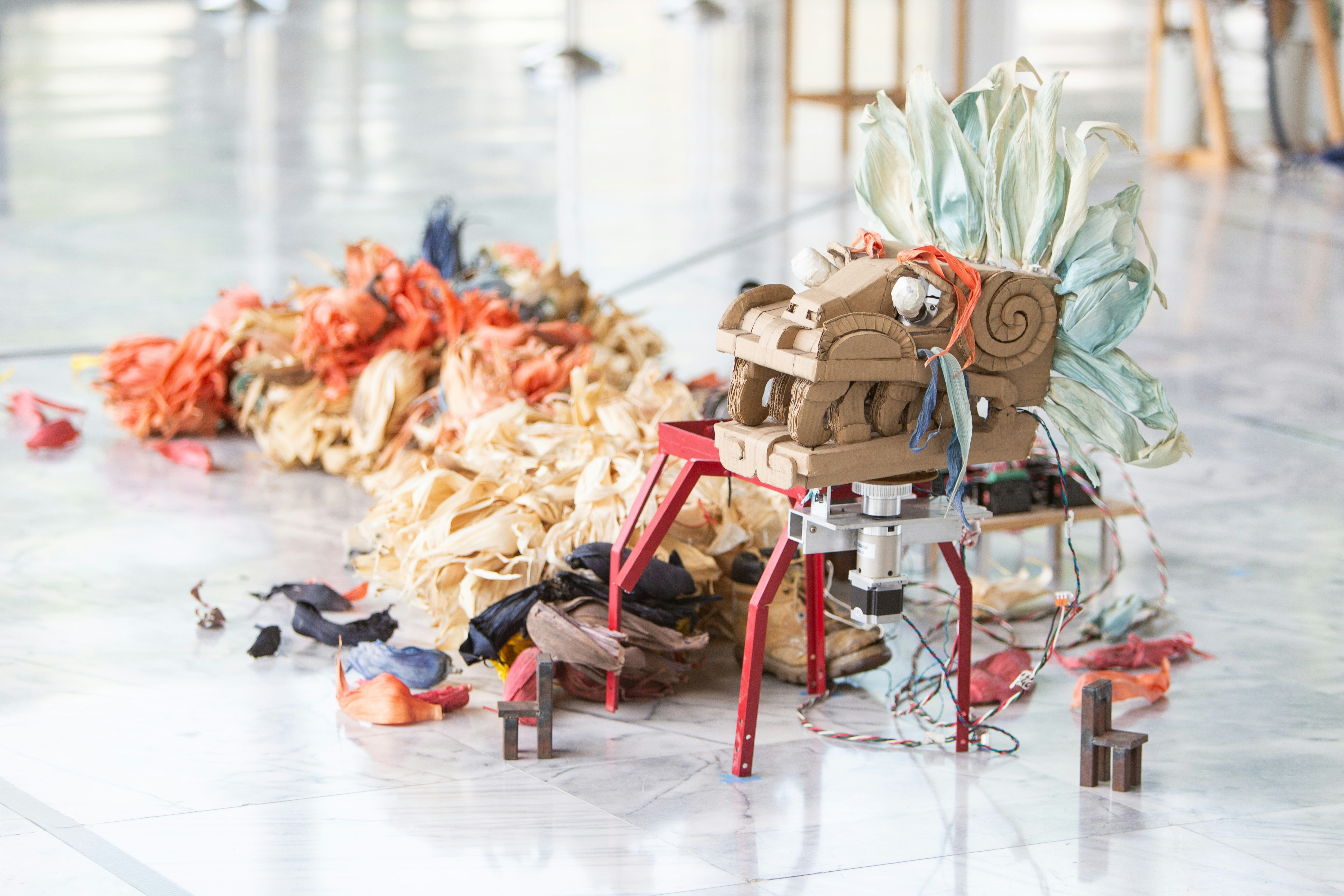Taipei Biennial 2020: You and I Don’t Live on the Same Planet | Review
Leora Joy Jones

Pierre Huyghe, Exomind (Deep Water), 2017, concrete cast with wax hive, bee colony, figure: 72×60×79 cm, beehive dimensions vary. Courtesy of the artist, Winsing Arts Foundation and Taipei Fine Arts Museum.
My father believes the earth is flat. My mother stands on a temporary planet and rests assured there are palaces built in heaven for her and her loved ones. The super rich build luxury bunkers to save themselves from natural disasters or civil war, while Indigenous communities in Taiwan leverage ancestral knowledge enabling them to live on the planet without destroying it. I see vistas wounded by humanity’s unceasing extraction. We may all live on the same planet, but there have always been divergent interpretations of our stations within it. Furthermore, a hidden cost is attached to these fragmented perceptions: consensus-less inaction when planet-wide decisions must be made.
Sensitive to the fracturing and widening divisions in contemporary society, particularly in relation to the ecological crisis, philosopher Bruno Latour (France) and independent curators Martin Guinard (France) and Eva Lin (Taiwan) chose to center the ways in which division and dissent define humanity’s approaches to current affairs. For the 2020 Taipei Biennial You and I Don’t Live on the Same Planet (21 November, 2020–14 March, 2021) these curators examined discordant perspectives on this blue orb we call home, ultimately highlighting the facade of global unity.
Held at the Taipei Fine Arts Museum (TFAM), this biennial was conceptualised before the pandemic hit, and while the ecological discord it addresses mirrors the divergent understandings of Covid-19, the multiple competing responses taken to combatting the virus are as varied and unharmonious as those employed to counter ecological devastation.
In order to express these different ideologies and embrace plurality, TFAM was framed as a “planetarium” with five distinct planets varying in scope, trajectory and gravitational pull.1 Some planets in this cosmos were expansive, while others housed a single artist’s work. Fifty-eight participants from 25 countries and territories were exhibited throughout the five celestial bodies, and as artists from around the world have particular planetary views, this organically folds differences into the planetary commons.
In orbit at TFAM was one planet for the masses, trapped in systems which prioritise extreme connectivity and resource extraction (planet Globalisation); a second for those seeking safety through protection (planet Security); one for the elite few who wish to bunker down in gated communities and underground bunkers, or colonise Mars in fear of imminent destruction (planet Escape); another for those who turn to metaphysical beliefs and spiritual forces for refuge (planet with Alternative Gravity); and lastly, the largest one served those wishing to comprehend the earth's boundaries, to better understand its mechanisms in order to galvanise change (planet Terrestrial). Exhibited in the same space alongside the show was a film program Shoreline Movements, as well as a series of public programs titled New Diplomatic Encounters, which provided a platform on which these different celestial bodies could “collide2 through discussions, debates and workshops.

Hu Tai-Li, still image from Voices of Orchid Island, 1993, documentary. Courtesy of Hu Tai-Li and Taiwan Film and Audiovisual Institute.
When discussing the earth and our view of it within the cosmos, it serves to look back at Ernst Haeckel’s 1866 conception of ecology 3— as the branch of biology dealing with the relations and interactions between organisms and their environment— which is far too innocent a definition. Ecology has been transformed into a “deeply political, contentious, and ideological”4 power, writes the art historian and cultural critic T.J Demos, entailing “a multifarious, complex, and at times contradictory pattern of bureaucratic rationalization, scientific and technological mastery, military domination, integration within the expanding capitalist economy, and legal systematization in order to manage and maximize the possibilities of resource exploitation.”5 In other words, ecology has been hijacked as the “science of empire, and empirical expansion routinely disregards the consequences of its growth.6 As such, the real roots of the ecological crisis are philosophical, emerging from a certain vision of humanity in relation to the physical world. The adverse effects of climate change and environmental devastation have its foundation in a Cartesian dualism,7 which posits human beings as subjects of the world, and everything else—including nature— as objects to be dominated, exploited, appropriated, and extracted. So much so that we have built up a human world, full of strip malls and freeways, and embedded tokens to nature within it, rather than adapting to nature. As Joni Mitchell sang fifty years ago, “they’ve paved paradise and put up a parking lot.”8 This subject/object binary (i.e. human mastery over nature) lies at the bedrock of the current climate crisis. “Can we imagine another way of responding to crisis,” the author Naomi Klein asks, “other than one of deepening inequality, brutal disaster capitalism and mangled techno-fixes?” 9 Recently, through platforms such as the UN, the Paris Agreement, and the Green New Deal, unity and global governance has been proposed as the solution to the blue planet’s wide-ranging wicked problem. Unified global governance has been perceived as the route out of this tangle of conflicts, but it has had very little capacity to mobilise change. Instead of unifying us, our contemporary understandings of ecology have begun to create more division, with the chasms between ideologies growing ever wider and deeper, and this serves as the show’s departure point. 10
Over the last twenty years the Taipei Biennial has repeatedly responded to the ecological crisis, as it is arguably the definitive issue of our time. A number of prior editions have proposed radical ways of reframing society’s approach to the environment, challenging prevailing normative beliefs that separate humans from nature. For the 2008 Taipei Biennial (13 September, 2008–4 January, 2009), curator Manray Hsu (Taiwan) and Vasif Kortun (Turkey) configured issues of the Anthropocene in overtly political ways: focusing on issues pertinent to human activity and its far-reaching ramifications, the artists’ conceptions of nature served as routes into scathing and humourous discussions on human behaviour, patterns and proclivities, rather than becoming the focus of the show.
Six years later in 2014, The Great Acceleration (13 September, 2014 –4 January, 2015), curated by the internationally recognised writer and curator Nicolas Bourriaud (France), was billed as “a tribute to the coactivity amongst humans and animals, plants and objects,”11exploring the many ways in which human activity has transformed the planet. In 2018, Mali Wu (Taiwan) and Francesco Manacorda (Italy) curated Post-Nature: A Museum as an Ecosystem (17 November 2018 - 10 March 2019), which was a mardi gras of planet terraforming — full of colour, sound and texture, eviscerating the audience with the destruction of nature in all of its various forms, while intermingling it with champions, defenders, and a hope to redefine our relationship with the living world. The 2018 Taipei Biennial captured the dynamism and interconnectivity of the natural world, challenging how humanity has perceived itself as separate to nature. For this show the museum itself was framed as an ecosystem. In contrast, the 2020 Taipei Biennial reads as an ode to humanity’s splintered and competing views of the natural world. It centred our perceived separation from it—and this is evident in how the museum was fractured into different ‘planets.’
The second floor of TFAM was densely packed with conflicting and dark global views. The three planets of Globalisation, Security, and Escape orbit uneasily, their close trajectories accentuating their contradictions. Touchdown on planet Globalisation reveals the fluid transportation of goods across borders and checkpoints, critically gesturing to our networks of extraction, capital and hyper-connectivity that prioritize purchases over people. Exemplary of this is Mika Rottenberg’s Cosmic generator (AP) (2017), a single channel video that tracks how mass-produced plastic wares are shipped from bulk Chinese markets to small towns near the Mexico border.
Exhibited nearby is a large pencil drawing After Art Basel (2020) by the Taiwanese artist Huang Hai-Hsin, which documents the dismantling of that fair in great detail, particularly resonant now, when so many artworks are swathed in bubble wrap. After Art Basel speaks directly to the economics of the market and the movement of cultural objects—nodding to the colorful abstract sculptures by Jean Katambayi Mukendi that are placed nearby. Sourced from the materials used to produce and package electronics in the copper mining companies found in Mukendi’s hometown, his “random (aléatoire)" 12 structures are made from cobbled-together discards, which are transformed into art objects, and then re-circulated to shows like Art Basel. The tiered levels of Mukendi’s Yllux (2012) resemble a homemade bomb disguised as a rickety dollhouse, electronic wiring covering its pastel facade. This is an exemplary physical manifestation of globalisation; at a meter 79 cm it stands as tall as I do, warning of imminent explosion, should policies continue prioritising market growth over planetary degradation.
A second work by Huang, River of Little Happiness (2015), has surreal scenes collaged from the thematics of the screen. Her visuals are sourced from social media and news outlets, accessed via the same devices Mukendi gathers his materials from. Huang ominously presents contemporary depictions of humanity coming undone.13
In garish colours, River of Little Happiness depicts clusters of people: some are on fire, while others lounge on sunbeds taking selfies; a person falls into an open manhole, while dancing bodies cry in a line near smoking factories. Placed together on planet Globalisation, these artists subversively mine the detritus of globalisation in divergent ways: using the distorted hyper-connectivity of an extractive system as their palette, they critically gesture to those people who are routinely discarded by the networks we are so dependent upon.
While planet Globalisation balefully nestled the pleasures of parties, shopping and celebrations found on social media alongside other darker horrors of global connection, even more sinister tones were found on planets Security and Escape. The former deconstructed these terrors in detail, to instil fear and sway beliefs; the latter offered respite from the myriad of possible terrors, although at a price.
On planet Security, Jonas Staal’s installation Steve Bannon: A Propaganda Retrospective (2018-2019) interrogated how the elite few justify an inherently problematic type of security enabled by propaganda, prejudice and the literal putting up of walls. Here, the Dutch artist painstakingly deconstructs the neo-nazi right-wing films of Steve Bannon14 to systematically reveal their mechanisms. Exhibited in two lines are scenes pulled directly from Bannon’s films, neatly separated for analysis. This categorised breakdown of the heavily curated propagandist films reveals how white supremacy will go to any length to remain intact, from building walls and cages, to demonising the perceived ‘other’ to justify abuse and invasion. Prominently displayed above these film clips are two chilling photos. In one, Bannon leans against a vehicle next to Trump, both men looking into the distance. In the other official photograph, Bannon is neatly erased. Months after the installation of this show, these altered images took on even more resonance; the day before Trump left office, Bannon was pardoned and absolved of all his crimes. Now you see him, now you don’t. Now you see him. Again.
In direct contrast with the multiple human evils presented on planet Security, planet Escape was inhabited by a single artist. Filled with eerie blue light and clad in swaths of delicate plastic clinging to silver steel scaffolding, Corrupted Air—Act VI (2019), by Dutch artist Femke Herregraven is an empty survival bunker with the clinical air of an abandoned laboratory. The only signs of life here are on three screens presenting the futuristic avatars of an extinct marine arthropod, an elephant bird and a lizard. In high pitched electronic voices they discuss the arrival of the ‘Last Man,’ a figure that, like Godot, ultimately never appears. Herregraven’s bunker preys upon the age-old theme of abandoning this planet completely, especially as the concept of a doomed earth gains more traction. This persuasion of escape is especially significant in light of the recent Rover landing on Mars15 and Elon Musk’s unwitting proposal of indentured servitude on the red planet,16 so people can pay off their debts. Back on earth, survival condos more lavish than Herregraven's clinical room are now being designed in response to a variety of threats to the earth, be it war, natural disasters or economic meltdown. Rather than addressing ecological destruction, the elite few on planet Escape can afford to bypass it.
After these exceedingly dark planets, which threatened to eclipse each other or implode, the voluminous planet Terrestrial revealed itself to be most similar in cartography and gravity to Attenborough’s Earth. Sprawling and dense, this planet examined the critical zone — the term given to the thin skin of the earth’s crust that reaches above our heads and below our feet; as well as the Gaia concept — conceived by scientists James Lovelock and Lyn Margulis which describes how the earth is a self-regulating system made of composite parts that constantly affect and regulate one another. The curators focused on these two grounded concepts to structure the terrestrial as a hybrid space that humanity has been folded into and impacted. As the curators posit that it is “still difficult to understand what it could look like” to gently live on earth, they conceptualised planet Terrestrial to “propose a set of ways to approach” this task.17 When stepping onto this planet, it became evident that many artworks employed to support these proposals were primarily framed within scientific and technological research.
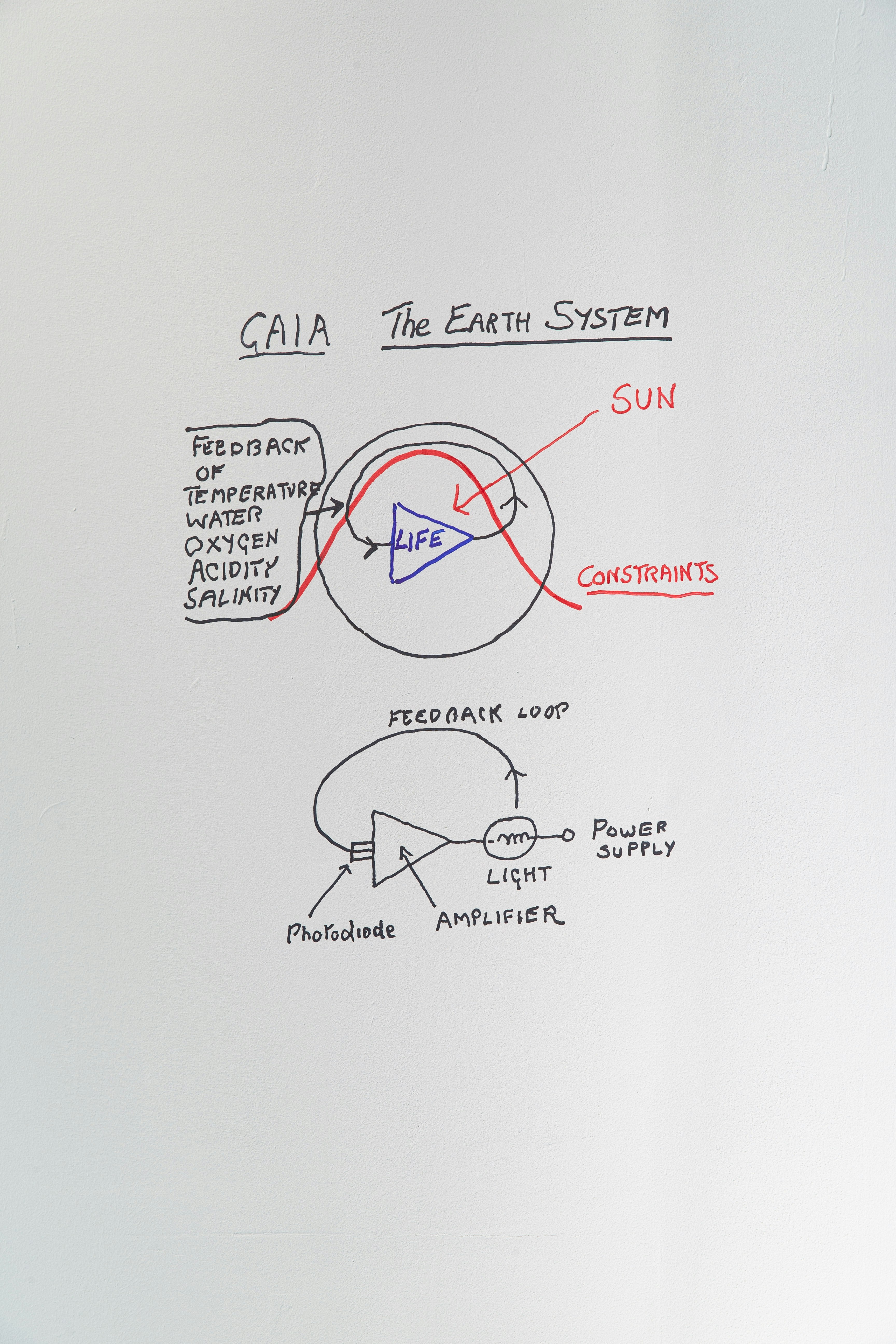
James Lovelock, Diagram of Gaia: The Earth system and feedback loop, illustration (reproduction). © James Lovelock, Science Museum and Science & Society Picture Library- All rights recerved.
Technology has always occupied a very exploitative role in humanity’s dominion over earth.18 It is never neutral, it has agency. The lead curator of this show, Bruno Latour, has been described as the founding father of Science and Technology studies, and so in the context of the show, it makes sense that there would be a considered use of technological tools to survey, map and analyse the earth. However, is the most effective approach for instigating change or imagining the planet anew to utilise the same tools that have been enlisted to reduce the earth to its current wounded and fragile state? Instead of providing an emphatic and rousing invitation to better live on earth, this approach reads as a cold, clinical and detached mode of persuasion.
Furthermore, the curators’ dependence on the flattened medium of film and screen-based works–integrating multiple lenses, projectors and cameras as the dominant medium to propose ways to thrive on a very living planet—suggested that the most effective way to grasp humanity's impact is through a mediated and ultimately two-dimensional and disconnected understanding of our exceptionally real earth.
As this blue orb is such a physical and living organism, the multiple screens showing ticking analytics, geo-mapping models, data-based graphs and multiple computer generated visuals indicated an abandonment of—or dissociation with—the physicality of earth.
In many works throughout the biennial, mediated screens and scientific advances alluded to a distancing of humanity from the physical reality of our home planet. Exemplary of this is the analytic and data-based work Oceans in Transformation (2020) by Territorial Agency. Composed of multiple tilted monitors protruding from the gallery floor, these screens formed a passageway in one of the larger galleries, and looped text and aerial footage catalogue a handful of the uncountable changes wrought to the world’s oceans, such as rising sea levels and the effects of oceanic farming practises. However, the corridor-like structure of the screens hurried visitors through it, turning the work into a hurtling and analytical litany of loss.
Likewise, in June Balthazard and Pierre Pauze’s ‘semi-documentary’ Mass (2020) an astrophysicist and a particle physicist dryly discuss theoretical models of existence and reality.19 Further video works provided more pragmatic and pedagogic routes to understanding our planet, although their protracted length and curatorial placement may have dissuaded many visitors from engaging with them in their entirety—such as the full-length two hour documentary film Symbiotic Earth: How Lyn Margulis Rocked the Boat and Started a Scientific Revolution (2017) by John Feldman that detailed the microbiologist’s contribution to science with the Gaia concept, as well as the notion that all life derives from a single cell; and Bruno Latour’s hour long performance play Moving Earths (2019) whereby the philosopher gives a lecture linking Galileo’s 1610 account of the rotating earth with current perspectives on it.20
While the curators’ representation of the planet via multiple flickering screens, films, videos, microscopes, drones and other lenses may have to suffice after climate collapse, their reliance on these flattened mediums to visualise and record earth can be seen to mirror our contemporary philosophical disconnect from earth — the very place they so implore visitors to connect with. Additionally, a third obstacle that became apparent was the fact that none of the video works on show, nor the supplementary film program Shoreline Movements housed in the basement, were available for remote viewers. This means it would require the most ardent visitor multiple visits and 24 hours of watch-time to wholly engage with the biennial films on display.21 Furthermore, while the works were curatorially fragmented into their respective planets, this also added to a sense of disconnection: certain prominent galleries were left empty and others had videos jostling for attention.
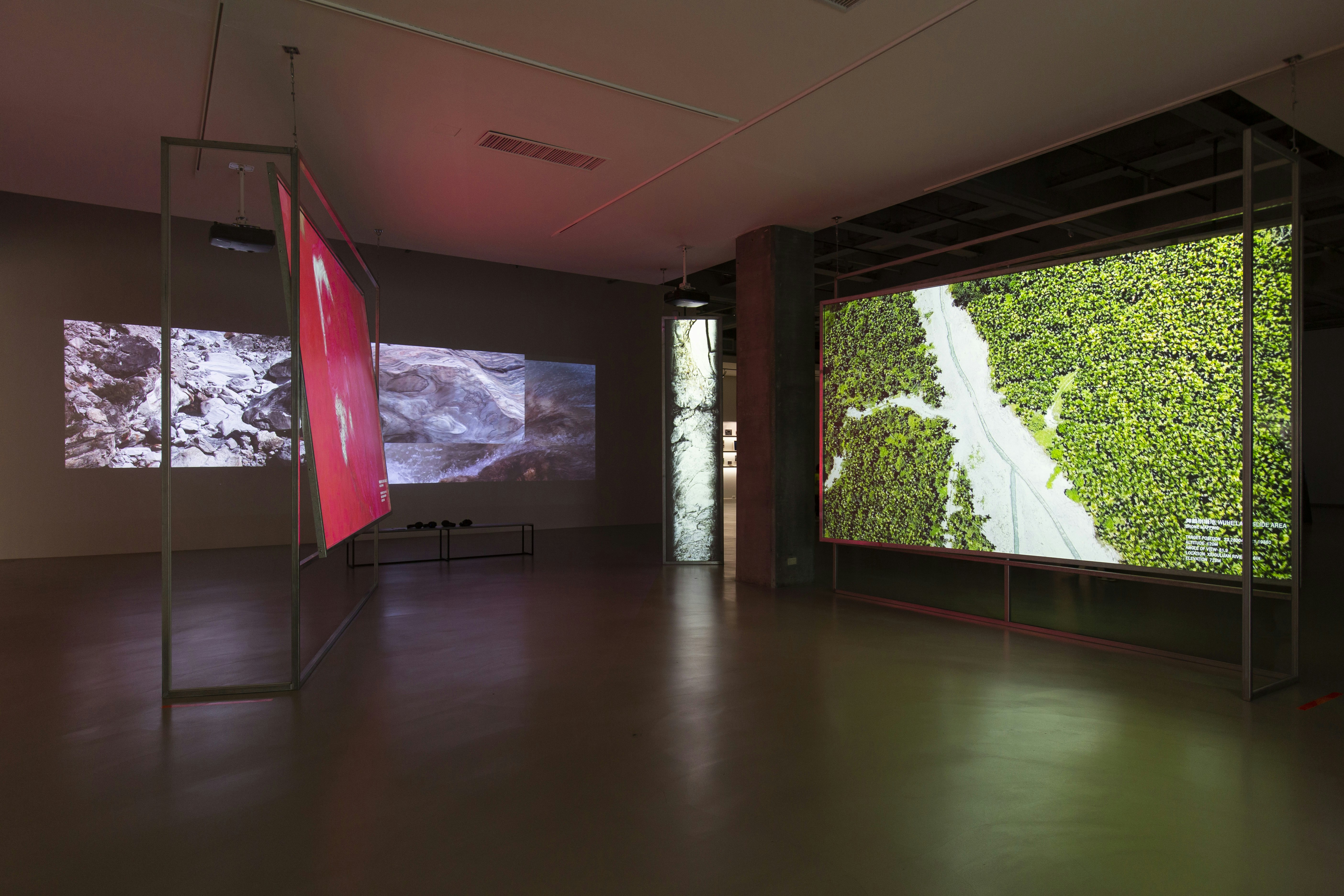
Su Yu-Hsin, Frame of Reference I, II, 2020, video installation, dimensions variable. Courtesy of the Artist and Taipei Fine Arts Museum.
As is evident on planet Terrestrial, the curators chose a number of works that employ the same technological devices and strategies that have been used to control and triumph over nature. However, the inclusion of Taiwanese artist Su Yu-Hsin’s films served as a critique of this approach's limitations. Su participated in a series of residencies at a Critical Zone observatory in Taroko Gorge, a breathtaking canyon on the east coast of Taiwan whose extreme weather patterns and striking geological erosion from earthquakes and landslides provide scientists with a wealth of data to understand earth’s (otherwise slow) processes. Su’s detached video works, Frame of Reference I, II (both 2020), reflect upon the location’s cartography—where kilometres of raw marble walls stretch high above the Liwu River—linking technological advances with ecological science, querying how the convergence of these two disciplines inform our understanding of the planet. Over aerial footage of the gorge, a woman’s voice softly asks “where is the observer standing?”—speaking both to those conducting research in the field, as well as to visitors of the museum. As scientific research, imagery and mapping are modes of representation, her work draws attention to the limitations of these frames of vision, serving as an examination of the visual politics of this kind of information. This work offered a nuanced criticality of the clinical methods primarily used to understand our green earth.

Liu Chuang, still image from Lithium Lake and the Lonely Island of Polyphony, 2020, 3-channel video, color, sound, 35 mins 55 secs. Courtesy of the Artist and Antenna Space.
Two video works stood in lush contrast with the otherwise clinical lenses trained on the planet. The three-channel film Lithium Lake and the Lonely Island of Polyphony (2020) by Chinese filmmaker Liu Chuang asynchronously interweaves the curious thread of polyphonic music through an exploration of China’s industrial manufacturing of litthrhium ore – a vital industry for a carbon-free future, as well as a key component of batteries and power supplies. In one scene, the lights of a large hydraulic mining plant flicker on and off in time to an aria, alluding to how evolution in music and sound is connected to technology. This installation serves as a culturally and historically rich inclusion in the show as it weaves together contemporary science fiction22 with academic theory, philosophy and indiginous communities’ oral traditions. In a similar manner, Interspecies Cinematic Encounters (2020) by Jean-Michel Frodon and Rasha Salti with Collective, also employed film to poetically reflect upon how humanity has been portrayed on film, particularly in its host of divergent relationships with the earth and its many inhabitants: be they animal, vegetable, mineral. In this installation seventeen looped videos on multiple frames were simultaneously played, portraying scenes from places like Iran (The Cow (Gav) dir. Dariush Mehrjui,1969), Thailand (Tropical Malady (Sud pralad) dir. Apichatpong Weerasethakul, 2004), and Serbia (Father (Otac) dir. Srdan Golubović, 2020). Planet Terrestrial employed numerous screen based works that map the world to make sense of it, by presenting expansive views or zooming in on microscopic detail.
Stepping away from these screens, visitors encountered a few handmade and textile pieces that served to, as Guinard explains, “map from within and not from above”, providing different representations of our relationship with human and nonhuman worlds.23 Take for example the works by Indigenous artists Cemelesai Takivalet and Aruwai Kaumakan, both of the Paiwan tribe. In the looming black and white mural Virus Series (2020) Takivalet depicts a writhing spate of viruses— reminiscent of the escapees from Pandora’s box—unleashed upon the world when a group of young researchers traversed a section of traditional territories that elders had warned must be left untouched. The inclusion of giant viruses painted directly onto the museum’s walls during a global pandemic leaves no room for subtext or interpretation.24
On the other hand, Kaumakan’s contribution Vines in the Mountains (2020) is a study in subtlety. For this towering deep-red textile installation Kaumakan worked alongside members of her tribe after a typhoon forced them to evacuate their homes. Resembling the assembled partitions of a shelter, this large woven work is composed of many smaller circular pieces cobbled together—soft and womb-like in colour and form—attesting to the shared labour of the work, and the tribe’s sense of community and integration in the face of disaster.
Turning away from these divergent stellar bodies to exit the show, I passed five kinetic sculptures by Mexican artist Fernando Palma Rodriguez, situated in the museum’s cavernous entrance foyer. These sculptures don’t neatly fit into the parameters of the planetarium above and are instead framed as the prelude to the biennial. These chimeras serve as physical embodiments of mythological figures from the artist’s Nahua tribe in Mexico. The shapeshifting coyote and the feathered snake shown here are mythological creatures, not just simple representations of animal deities; they hold powerful roles in many Mesoamerican cultures. Soldado (red), and Soldado (azul) (both 2001) are coyotes composed of bright metal armitages with angular cardboard heads mechanised to move jerkily across the floor.
Nearby was Quetzalcoatl (2016), a depiction of the plumed serpent — revered in some cultures as the father of humanity. Its corn-husk belly was pressed against the cold marble floor, its raised head uncannily similar to the dragons perched on the roofs of temples across Taiwan. These human-sized works cobbled together from steel ladders, paint-splattered boots, dyed corn husks and other natural grasses and fibers are connected to electrical circuits, thus expanding the lives of these objects by invigorating them, as well as redefining what waste is. Their shapes reference folk legends and tribal beliefs, their materials and kinetic elements addressing contemporary issues such as ecological devastation and Indigenous land rights.
However, spaced widely apart from each other across the expanse of cold white marble in the capacious entrance foyer, these deities appeared frail and out of place — their scale rendering them insignificant. On my first visit to the show on opening day, a technician was tending to the two coyotes.25 The red one leaned back then tipped precariously, before crashing down. The technician gently set it upright and turned it off. Later, I saw the little soldiers had been equipped with wooden boards to keep them in line. The last time I visited the show many of the electrical circuits had been disconnected, leaving the mischievous coyotes frozen and forlorn. One was missing a glove. The quills on the head of the plumed serpent had drooped. Could the souls of these gods have chosen to leave these chimeras, crossing the Pacific to return to where they are appreciated and can feed on plentiful prayers?
By situating these sculptures in the foyer, as the prelude to the planets, perhaps the curators wished to remind visitors there are other horizons? Perhaps the prelude is also the postscript and serves as an alternative route away from these divisive planets? Perhaps, by framing division and dissent, the curators aimed to have this fracturing of the earth to serve as a guide to integration and connection? Unlike many works in this show, Palma Rodriguez’s chimeras gestured to the interconnection between all life forms and the need for coexistence between humans and nature.
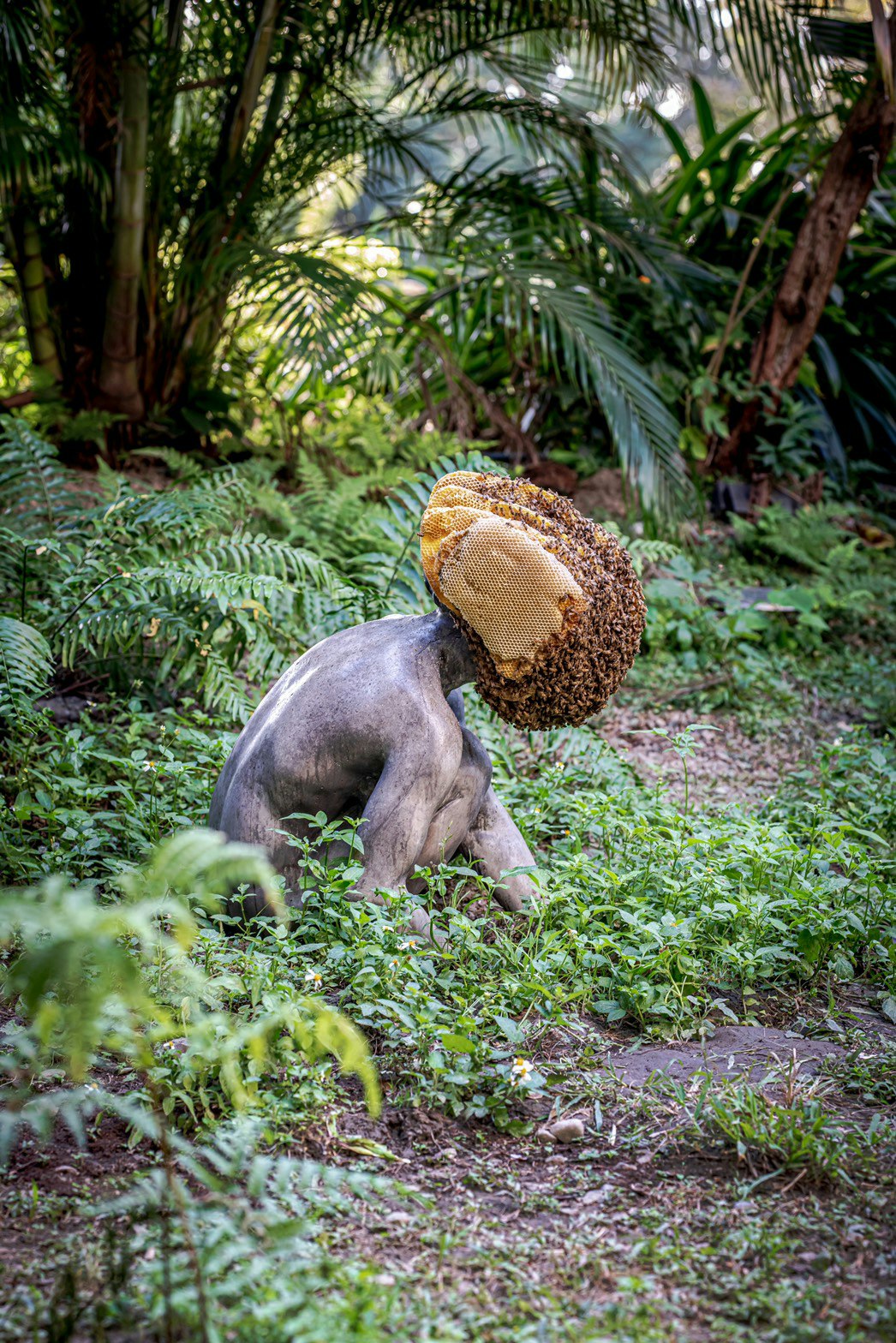
Pierre Huyghe, Exomind (Deep Water), 2017, concrete cast with wax hive, bee colony, figure: 72×60×79 cm, beehive dimensions vary. Courtesy of the artist, Winsing Arts Foundation and Taipei Fine Arts Museum.
Tucked away in a small garden that hugs the south walls of the museum was Pierre Huyghe’s Exomind (Deep Water) (2017), a sculpture of a crouching woman with a beehive that “grows”on her head. 26At the start of the show this hive flourished, and visitors —at a safe distance— could watch as the bees navigated their new territory. Designed to be “self-organizing” and “co-evolving” 27 with both living and nonliving components fused in a single piece, Exomind instead served as an exercise in futility. Over the duration of the exhibition, this hive slowly began to lose its inhabitants while the plants around the woman’s kneeling body grew, ultimately hiding her under rustling ferns and weeds.
Visitors leave the latest biennial with an unsettling glimpse into why we seem so powerless in preventing the destruction of the other forms of life with whom we share this planet: we have divisive views of the world, and little common ground to meet upon, few places from which to discuss or shift the planet’s current trajectories or to bridge the divides between them, and strip away the facade of global unity. The title You and I Don’t Live on the Same Planet is both a disheartening admission of our fractured selves as well as a proactive call to pay attention to our discordant differences, and to center modes of communication that may lead to reconciliation.
The curators proposed we must first acknowledge and accept division and only then can we “bring together a diverse range of people” as Guinard explains, to discuss and understand each other “especially if there are opposing points of view.”28 Accepting these many different approaches to the earth may allow me to enter into conversations about the Nahua’s belief in shapeshifting deities with a father who believes the earth is flat, and to discuss ecological degradation with a mother who waits for heavenly palaces.
While the premise of the 2020 Taipei Biennial is commendable and ambitious, working to employ diversity and dissent as a route to understanding and healing our vulnerable planet, the show narrated a more generalised and western viewpoint of the planet–in a discussion with his co-curators, Guinard acknowledged that this biennial is “curated by two Europeans from a country with a colonial history; 29 and this came through in the number of planets that accentuated western modes of thinking that prioritize escape and building gated communities. Nevertheless, acknowledgement of their position as guests is evident in their own invitation extended to Taiwanese independent curator Eva Lin to assist them in spearheading the public programs, which did offer a more integrated lens on the earth through facilitated expeditions, fieldwork and conversations.
Since approximately half of the works for the 2020 Taipei Biennial were screen-based, in-person viewing became a format that required lengthy and repeated viewings to allow a complete digest of the program. Furthermore, the virtual tour excludes the films that punctuate the show. Instead, one swans through rooms of static video installations, with films stopped mid-scene, so online visitors look at dead screens through their dynamic screens. This further muddies the notion of the Biennial's wide-ranging breadth, especially now that moving images are becoming more extensively distributed and accessible.
Ultimately, the 2020 Taipei Biennial proved to not be as heterogeneous as the curators intended, but offered instead a more essentialist and narrow depiction of dissent that centred the west “in spite of the varied peoples alluded to by the far-reaching scope of the Biennial." 30 Perhaps the cultures and worldviews on display served to fit the curators’ conception of diversity, ultimately revealing a more similar cosmology than they might expect? Multiple approaches were accentuated throughout the biennial, but the works exhibited across the museum’s many floors predominantly reflected the perspectives of those with power and privilege, expressing a stifled, Western-centric perspective.
Notes
-
Quote from Bruno Latour and Martin Guinard, “Introduction,” You and I Don’t Live on the Same Planet 2020 Taipei Biennial Guide Book (Taipei: Taipei Fine Arts Museum, 2020),16.
These five planets were initially conceived by Bruno Latour, and for this biennial they were adapted from a 2018 essay which outlined seven planets: planet Globalisation, planet Anthropocene, planet Exit, planet Security, planet Modernity, planet Terrestrial and planet Vindication. This fictional planetarium was initially presented as the Loeb lecture at the Harvard Graduate School of Design on Oct.16, 2018, and included in the catalog for Design for Different Futures. Bruno Latiranour, “We Don’t Seem to Live on the Same Planet” Design for Different Futures. Edited by Kathryn B. Heisinger and Michelle Miller. (Philadelphia Museum of Art & The Art History of Chicago, 2019), 193-199.
-
TFAM, “Taipei Biennial 2020 Public Programs,” You and I Don’t Live on the Same Planet 2020 Taipei Biennial Guide Book (Taipei: Taipei Fine Arts Museum, 2020), 110.
-
From the Greek: οἶκος, "house", or "environment"; -λογία, "study of", Ernst Haeckel’s 1866 definition stated Ecology to be “the body of knowledge concerning the economy of nature—the investigation of the total relations of the animal both to its organic and inorganic environment.” Ernst Haeckel, cited in J. Donald Hughes, An Environmental History of the World: Humankind’s Changing Role in the Community of Life (New York: Routledge, 2009), 7.
- Demos, T. J, “The Politics of Sustainability: Contemporary Art and Ecology.” Radical Nature: Art and Architecture for a Changing Planet 1969–2009. Edited by Francesco Manacorda, (London: Barbican Art Gallery, 2009),16–30. http://www.environmentandsociety.org/node/3417
- T.J. Demos, Decolonising Nature (Berlin, Sternberg Press, 2016), 14.
- Libby Robin, quoted in Decolonising Nature, (Berlin, Sternberg Press, 2016), 14.
- Originating from Rene Descartes, Cartesian dualism is otherwise known as Mind-Body Dualism, and Descartes conceives of the mind as opposed to and superior to the physical world.
- “Big Yellow Taxi” Spotify, Track 10, on Joni Mitchell, Ladies of the Canyon, Reprise Records, 1970
- Naomi Klein quoted in T.J. Demos, Decolonizing Nature (Berlin, Sternberg Press, 2016), 16.
- Recently this is most evident in the range of responses to the Green New Deal, a gigantic industrial proposal to move industries across America to use renewable energy. Criticised by some as greenwashing, the Green New Deal is a contentious proposal. This was proposed in the 2021 elections, and is strikingly similar to the 2019 attempt by Rep. Alexandria Ocasio-Cortez and Sen. Ed Markey. In 2021, Joe Biden chose to not endorse the deal in its entirety, however he did rejoin the Paris Agreement.
- Nicolas Bourriaud, “Introduction,” The Great Acceleration: A Tribute to the Coactivity Amongst Humans and Animals, Plants and Objects Guidebook (Taipei: Taipei Fine Arts Museum, 2014), 1.
- TFAM, “Jean Katambayi Mukendi,” You and I Don’t Live on the Same Planet 2020 Taipei Biennial Guide Book (Taipei: Taipei Fine Arts Museum, 2020), 26.
- This painting is reminiscent of Hieronymous Bosch’s Garden of Earthly Delights (1510-1550) in title, composition and theme. In both paintings, there are multiple muddles of bodies engaged in bizarre acts of harm and pleasure.
- Bannon is an ultra right propagandist who briefly served as the chief Whitehouse strategist for Trump in 2016, and a year later was arrested and charged for defrauding over 25 million dollars to initiate the building of the US/Mexico wall.
- Nasa’s robotic rover Perseverance successfully landed on Mars on February 18, 2021 to search for possible bacteria or other microorganisms which could indicate previous life forms.
- Elon Musk (@elonmusk) was asked if people could work off their Mars property loans. “Replying to @Kristennetten @PicklePunchD and @Erdayastronaut. Yes. There will be a lot of jobs on Mars!” Twitter. January 17, 2020.
- TFAM, “Planet Terrestrial” You and I Don’t Live on the Same Planet 2020 Taipei Biennial Guide Book (Taipei: Taipei Fine Arts Museum, 2020), 57.
- Multiple avenues of research (in many fields from anthropology to science) have explored technology’s role in colonisation. For Scientific American, Curtis W. Marean discusses how Homo sapiens have collaborated to utilise weapons and technological innovation to colonise the world, describing humans as the most invasive species on the planet. Curtis W. Marean, “How Homo Sapiens Became the Ultimate Invasive Species” Scientific American. August (2015), 33-39.
- TFAM, “June Balthazard and Pierre Pauze” You and I Don’t Live on the Same Planet 2020 Taipei Biennial Guide Book (Taipei: Taipei Fine Arts Museum, 2020), 122.
- Both Mass (planet with Alternative Gravity) and Moving Earths were housed in the basement alongside the film program “Shoreline Movements” and Moving Earths served as a summation to many themes explored in the show. However, by the time visitors moved all the way downstairs, the curatorial placement of lengthy videos in darkened rooms at the far reaches of this celestial tour discouraged participation. Furthermore, this floor resembled a burial ground more than anything else, and this was accentuated by the various darkened rooms that housed multiple films as well as the ghostly white bones of the plastic chairs laid out for the film program. In addition to this, not to be glib, the inclusion of Chen Yin-Ju’s Liquidation Maps (2014), hand drawn astrological charts of five devastating massacres across Asia, literally explores ideas of burial grounds.
- In order to fully appreciate the 18 videos in the film program (collectively over ten hours of film), visitors would need to return to the museum at least six times throughout the duration of the show, as they are shown only at weekends. Nearly half of the works on display throughout the biennial had a screen-based component as an integral part of the installation (often, no specific length or duration was provided) which reinforced my query of whether the most effective of instigating change was through the same modes that allowed humanity to exploit the planet.
- Such as Liu Cixin’s novel Three Body Problem (2008), Stanley Kubrick’s 2001 Space Odyssey (1968) and James Cameron’s Avatar (2009).
- Martin Guinard, personal communication with the author while on a walkabout tour of the 2020 Taipei Biennial, TFAM. December 03, 2020.
- Robin Peckham writes that the subject is “somewhat on the nose in the age of COVID-19”. Robin Peckham, “This Piece of Land, These Bits of Sea,” Mousse Issue 74, Winter,(2021).
- As many artists were unable to attend the opening due to the current travel restrictions, TFAM assigned technicians and other staff to help with the installations.
- TFAM, “Pierre Huyghe” You and I Don’t Live on the Same Planet 2020 Taipei Biennial Guide Book (Taipei: Taipei Fine Arts Museum, 2020), 102.
- Ibid.
- Leora Joy Jones, “A Conversation with Martin Guinard: 2020 Taipei Biennial,” Yishu Journal of Contemporary Chinese Art May/June 2020:102-109
- Martin Guinard, “Discussion between Bruno Latour, Eva Lin, and Martin Guinard,” OnCurating Issue 46, June (2020), 85-89. https://www.on-curating.org/issue-46-reader/discussion-between-bruno-latour-eva-lin-and-martin-guinard.html#.YCyHqHczaRs
- Christopher Whitfield, “Taipei Biennial 2020: You and I Don’t Live on the Same Planet,” ArtAsiaPacific March/April 2021: 74-75
About the contributor
Leora Joy Jones is a poet, photographer, writer, and arts practitioner.
